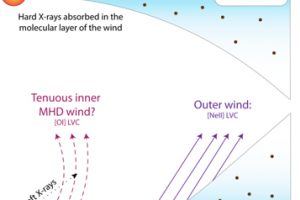Winds and jets from protoplanetary disks. The study: “The Evolution of Disk Winds from a Combined Study of Optical and Infrared Forbidden Lines” of I. Pascucci (The University of Arizona) recently appeared on A&A

The study of protoplanetary disks (which are disks orbiting around young pre-main sequence stars) is of great interest since planets formation occurs in these structures. Disks are dispersed in a few million years (typically less than 10 Myrs) by the planets formation itself, the accretion of material onto the central star, and the loss of material launched in a highly collimated jet with velocity of several km/sec from the inner region of the disk, or in a low-velocity wind launched from most of the outer disk surface.
Winds and jets in disks can be studied with spectroscopic observations at high spectral resolution. In fact, the gas in winds and jets is typically at the low density at which atoms can emit radiation as forbidden emission lines. Besides, unless the disk is observed edge-on, only the component of winds and jets moving toward us is visible from Earth. Because of Doppler effect, thus, the forbidden emission lines emitted by disk outflows typically show a blue-shifted component, with a separation from the central wavelength which increases with the velocity of the outflow.
The team led by Ilaria Pascucci, associate professor of the Astronomy Department of the University of Arizona, analyzed high resolution spectra of 31 protoplanetary disks obtained with the VISIR2 spectrograph of the European Southern Observatory. In particular, the spectra included the forbidden lines at 0.63 μm of Oxygen ([OI]) and at 12.81 μm of Neon singularly ionized ([NeII]), typically used as diagnostics for disks outflows. The [OI] forbidden line is observed in 17 disks, and it always shows both a blue-shifted low velocity component (LVC) emitted by the wind, and the high-velocity component (HVC) emitted by the jet. The [NeII] line shows instead either the LVC or the HVC component. In particular, the less evolved disks with more intense accretion of gas onto the central star show the HVC of the [NeII] line, while the more evolved disks, with less intense accretion and a cleared inner cavity, the LVC. This difference is likely explained by the fact that the Ne atoms are ionized by incident X-ray photons emitted by the central star. In the less evolved disks, the stellar X-ray photons are likely absorbed by a dense wind launched by the inner disk and probed by the [OI] line. In the more evolved disks, the stellar photons are not absorbed by this wind component, and they can reach and ionize the Ne atoms in the outer disk wind. This study is described in the paper: “The Evolution of Disk Winds from a Combined Study of Optical and Infrared Forbidden Lines“, recently appeared on The Astrophysical Journal, and it shows how disk winds diagnostics can probe the evolution of disks and their outflows. Among the coauthors, the astronomer E. Flaccomio of INAF – Astronomical Observatory of Palermo.
The figure (click here to visualize the entire image) shows the evolutionary scenario discussed in this work. In the top panel, the disk is not evolved yet, and the wind launched from the inner disk absorb the X-ray stellar photons. In the bottom panel, the disk is evolved, and the inner disk wind, if any, does not absorb the stellar energetic photons that can reach and ionize the gas in the outer disk wind.
